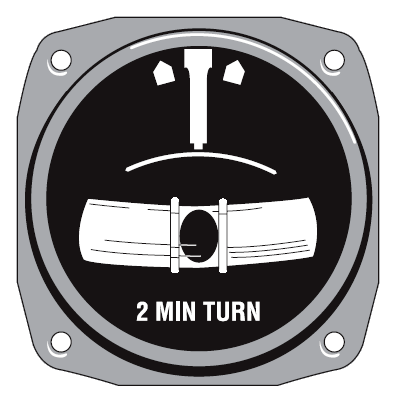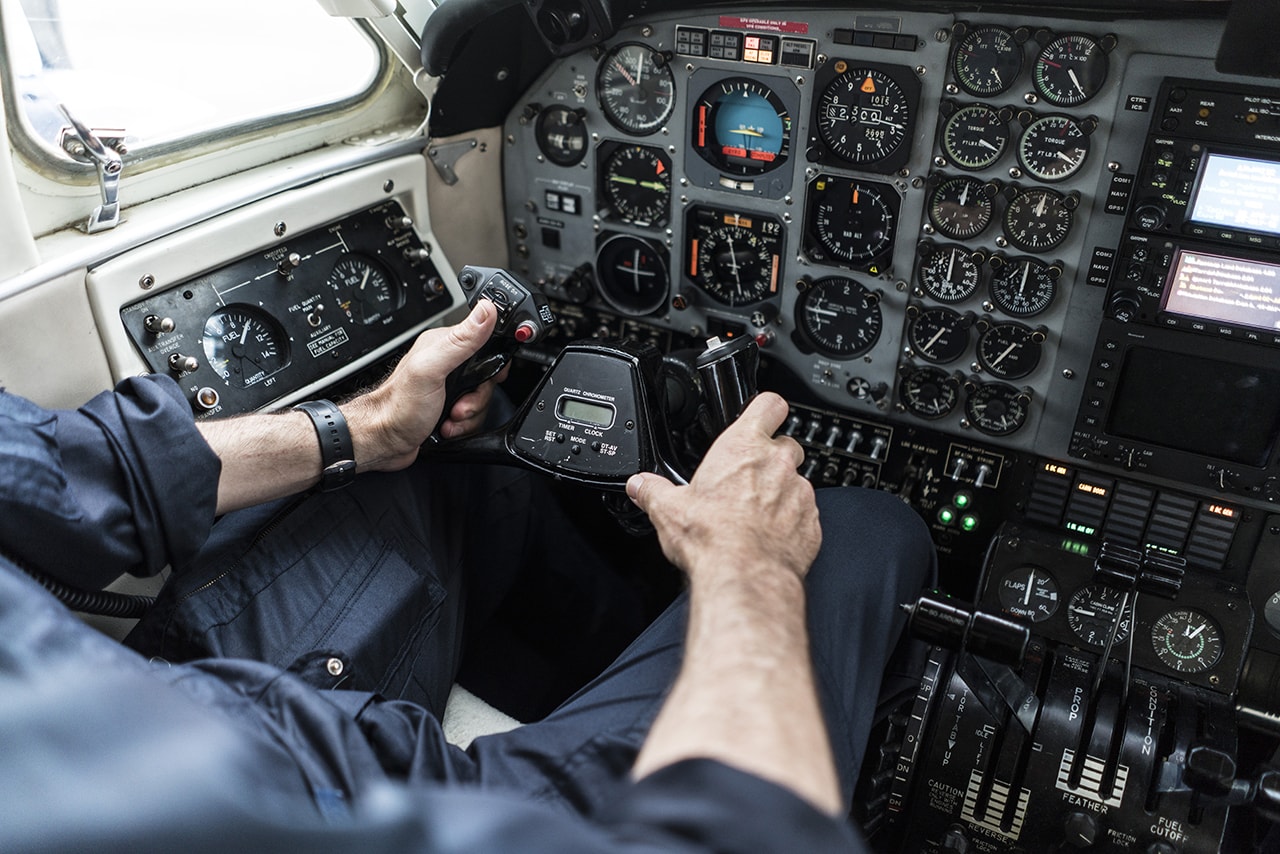Mastering the Turn Coordinator: A Comprehensive Guide
Oct 10, 2024Understanding the Turn Coordinator's gyro
The turn coordinator is a key instrument in the cockpit, giving pilots the information they need to make smooth and controlled turns.
It’s a multi-function instrument that combines two instruments in one: the turn indicator and the slip/skid indicator (inclinometer).
The turn coordinator is gyro driven, with the gyro mounted 30 degrees up from the longitudinal axis of the aircraft.
This allows the turn coordinator to sense rolling, yawing and turning movements and give the pilot feedback on the aircraft’s attitude and movement.
By understanding what the turn coordinator does, pilots can see how it helps with coordinated flight.
The turn indicator shows the rate of turn, the slip/skid indicator shows you if you’re out of balance, and the Vertical Speed Indicator provides crucial data on the aircraft's climb or descent rate. This information is key to making precise maneuvers and flying safely.
The Importance of the Turn Coordinator
The turn coordinator is key for IFR pilots. It’s your best friend when flying in low visibility, allowing you to control and be aware of your aircraft’s turns and roll.
Compared to the attitude indicator, the turn coordinator provides a more focused view on turn rate and coordination, making it a reliable backup system.
This clever device combines two instruments in one, showing you the rate of turn and any slip or skid.
The turn and slip indicator complement this functionality by providing additional insights into the aircraft’s yaw and coordination.
Additionally, the turn coordinator displays roll information, which is crucial for assessing the coordination of turns and determining the necessary bank angle for specific turn rates.
By showing you both, you can make informed decisions and have a smooth and safe flight.
One of the main uses of the turn coordinator is to help you determine the right bank angle to achieve a specific rate of turn. For example, to do a full circle, 360 degrees turn in 2 minutes.
In the cockpit the turn coordinator isn’t just another instrument – it’s essential. It provides critical information that pilots rely on to control the aircraft and be efficient, especially when visibility is compromised.
The turn coordinator is part of the basic aircraft 6 Pack Flight Instruments which is the basic instruments every pilot needs. This setup gives you an overview of the aircraft’s direction and heading changes in a turn.
So, use the turn coordinator and fly with confidence. It’s a must have in your bag of tricks for both training and real world.

Components and Operation of the Turn and Slip Indicator
The turn coordinator's gyro is a clever device that uses a gyroscope mounted at a certain angle to do its magic. This gyroscope is mounted 30 degrees up from the longitudinal axis of the aircraft.
This setup allows the instrument to detect movement and help the pilot control the aircraft. By knowing every little bit of rotation, the turn coordinator is crucial for safe and precise flight in low vis.
What makes the turn coordinator unique is it can sense rotation around both the vertical axis and longitudinal axis. This is because the gyro is mounted between 30 to 45 degrees above the back of the aircraft.
This dual sensing is important for pilots as it gives them complete information on how the aircraft is flying. By knowing this, they can make decisions and adjustments and have smoother and safer flights.
In terms of operation, the turn coordinator can be powered electrically or through a vacuum system. In older models, the vacuum pump plays a crucial role in powering the gyro, ensuring functionality even when electrical systems fail.
Having both options is good because it means the instrument will still work if one system fails.
For example, the electrical turn coordinator can be a backup bank indicator if the vacuum system goes down. This redundancy adds another layer of reliability to the instrument and makes it a critical part of the aircraft’s nav system.
The design of the turn coordinator is simple; it has two white lines called turn alignment marks. These are on the sides of the instrument and tell the pilot what bank angle is needed to achieve a certain rate of turn.
Unlike the turn and slip indicator, the turn coordinator senses roll, not yaw. This distinction is crucial when comparing Turn Coordinator vs Turn and Slip because the turn coordinator provides a more precise rate of turn display. This is good for pilots to make accurate turns and ensure safe and efficient flight.

How to Use the Turn Coordinator
To use the turn coordinator effectively, pilots must understand its components and how to interpret the information it provides. The turn indicator, represented by a small airplane symbol, rotates right or left depending on the bank angle and rate of turn.
This visual cue helps pilots gauge the aircraft’s turning performance and make necessary adjustments.
The slip/skid indicator, a black ball suspended in a liquid-filled tube, rolls right, left, or remains in the middle, depending on the aircraft’s slip/skid (balance) condition. When the black ball is centered, the aircraft is in coordinated flight.
If the ball moves to the right or left, it indicates a slip or skid, respectively. Pilots can use the rudder to correct these imbalances and bring the ball back to the center.
By monitoring these two indicators, pilots can determine the coordination of their turn and make adjustments as needed to maintain a smooth and controlled flight path. This ensures that the aircraft remains balanced and responsive, enhancing overall flight safety.
Mastering Turns and Bank Angle with the Turn Coordinator
The turn coordinator is a vital tool to help you make smooth and precise turns. Its job is to make sure those turns are done at standard rates, so you stay safe and in control flying.
A standard rate turn is 3 degrees per second. This way you can predict the aircraft’s movement and stay on the correct path, it’s more intuitive and reliable.
This instrument is essential to give you critical flight information. By reading the turn coordinator, you can keep the aircraft steady and controlled, and overall safe and efficient flying.
One of the turn coordinator’s functions is to calculate the bank angle for a given rate of turn. For example, you can do a 360 in 2 minutes, calculated and precise.
The turn coordinator uniquely measures the roll rate of the aircraft due to its gyro's specific mounting angle. This helps in determining the rate of turn during flight. By giving continuous feedback, pilots can adjust and adapt their approaches to meet standards and regulations.
Overall, the turn coordinator is key in modern aviation to safe and precise turning. It gives pilots the confidence and information to master complex turns.

Avoiding and Correcting Slips and Skids for Coordinated Flight
The turn coordinator has an inclinometer which shows rate of roll and yaw and indicates the aircraft's coordinated flight by displaying the ball's movement in the opposite direction of the turn. This helps the pilot to keep his turns coordinated.
When the black ball on the inclinometer goes outside the lines, it’s time to use the rudder. This will bring the ball back to the center and you’ll be back in balance.
Slips and skids are bad situations to be in. The turn coordinator will help you detect them early.
By knowing slip and skid, you have better control of the aircraft and avoid problems in flight.
The turn coordinator information is key. It helps you avoid slips and skids and correct them.
Having this will allow you to make informed and safe decisions and have a safer flight for everyone on board.
Advanced Techniques
In addition to its primary function of providing turn coordination information, the turn coordinator can also be used to execute advanced flight maneuvers.
For example, pilots can use the turn coordinator to perform a standard rate turn, which is a 3-degree-per-second turn that takes two minutes to complete a 360-degree turn.
By aligning the turn alignment marks on the turn coordinator with the horizon, pilots can ensure a precise and controlled turn.
Additionally, the turn coordinator can be used to detect and correct slips and skids, which can be critical in maintaining control of the aircraft during turns.
When the black ball moves outside the center, it indicates a slip or skid. Pilots can use the rudder to correct these deviations and bring the ball back to the center, ensuring coordinated flight.
By understanding the turn coordinator’s capabilities and limitations, pilots can develop advanced techniques to improve their flying skills and safety.
Mastery of this instrument allows for more precise maneuvers, better control, and ultimately, a safer flight experience.

Practical Applications
The turn coordinator is a student pilot’s best friend when learning patterns and advanced maneuvers. It’s a fundamental tool to help them understand aircraft control, alongside other essential instruments like the Airspeed Indicator.
One of the main uses of the turn coordinator is during crosswind landings. Mounted along the aircraft's longitudinal axis, it helps pilots align the aircraft with the wind more efficiently, which is crucial for a safe landing.
Pilots can also intentionally put an aircraft into a slip for practical reasons. For example, a forward slip will get you down fast and a sideslip will help with crosswind landings.
Knowing the bank angle for a given rate of turn is key to precise flying. The turn coordinator helps you figure this out, for example a 360 in 2 minutes.
In flight control is king. The turn coordinator gives you the information you need to adjust and correct as you go and makes for a smooth and steady flight.
Overall, it gives you the information and control feedback to make informed decisions and fly safe and efficient.
Enhancing Pilot Confidence with the Turn Coordinator's Gyro
The turn coordinator is a vital tool in aviation, helping with the technical side of flying. It gives you real time feedback so you can fly with confidence.
By giving you reliable information the turn coordinator makes you feel good about your decisions and reduces the stress that comes with difficult conditions or unexpected events.
You can rely on the turn coordinator’s indicators to guide your movements. This means more reliable and efficient turns.
When things get tough in the air you are better equipped to adapt and stay stable and safe with the turn coordinator on your side.
So, you can focus on the job and fly smoother and better. In short, the turn coordinator gives you the confidence to go out and fly.
Conclusion
The turn coordinator is a pilot's best friend, giving them all the data they need to fly the plane. It tells them where the plane is and how it’s turning.
Mastery of this tool is key to safe and proficient flying. Familiarity means pilots can fly and manage the maneuvers with confidence and safety for the passengers and crew.
Knowing bank angles and turn rates is another important part of using the turn coordinator. For example, it lets you do a 360 in 2 minutes.
In summary it helps you to control, mitigate risk and fly smooth. It becomes second nature to every flight.

